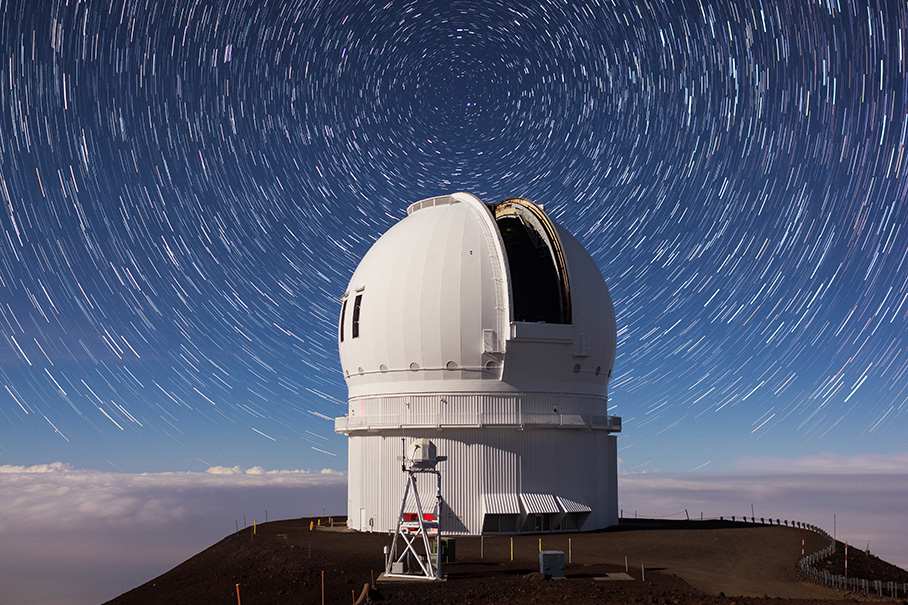Maunakea Observatories to Return to Limited Operations
John O'Meara W. M. Keck Observatory

Star trails over the Canada-France-Hawaii Telescope on Maunakea.
Courtesy Tayte Brock, the Bennet Group, and Maunakea Observatories.
Science operations on Maunakea have been halted since July 16th. Safe, full, regular operations require use of the Maunakea Access Road, which remains blocked, but some progress is being made on a return to limited operations. The following text is adapted from a press release issued on August 9th. The full release is available as a PDF, linked below under RESOURCES.
After a four-week suspension of work at the summit of Maunakea, the existing telescopes will attempt a return to operations.
The Maunakea Access Road remains blockaded. However, activists agreed, after the Emergency Proclamation was withdrawn, to allow all existing observatory employees, including astronomers, to access Maunakea using the Old Saddle Road and a section of unpaved lava. This route is unimproved and lined with tents, cars, and people. However, pursuant to this agreement, on Wednesday, 7 August 2019, the State laid cinder and cones in an attempt to address safety concerns. The people blocking the road also agreed to allow larger vehicles to access Maunakea by going around the tent blockade. This means the vehicles will travel on the road's shoulder.
The current process of gaining access to Maunakea requires the observatories to provide prearranged notification of all vehicles seeking access. To accomplish this, the people blocking the road will be provided a list of which vehicles are going up and when. This requires the observatories to contact the Office of Maunakea Management, which then contacts law enforcement, who then provides the list to the activists. The observatories are also aware that activists have been keeping a log of who goes up and down.
This arrangement — and the improvements made by the state to address safety concerns and ensure appropriate access for the observatories — constitutes progress. The observatories hope this process will allow them to return to as close to full operations as possible while the Maunakea Access Road remains blocked. However, the state, county, and observatories remain committed to reopening the blocked Maunakea Access Road intersection to vehicular traffic so that access will be unimpeded and prior notification and/or approval by the protesters will no longer be necessary.
The Observatories plan to send regular day crews back to the summit to prepare the telescopes to resume operations. During the prolonged shutdown, some instruments and systems were disabled to protect the health of the technology, so the restart process will vary in complexity from telescope to telescope. The Observatories hope to resume scientific observations as soon as possible.
"The Maunakea Observatories thank the state and county for their statements of support for a continued vibrant astronomy sector in Hawaii," said Hilton Lewis, director of the W. M. Keck Observatory. "We are deeply committed to our community here on Hawaii Island and are eager to get back to work at our telescopes as soon as possible, to resume the world-leading astronomy for which Hawaii is renowned."
This four-week suspension has been the longest period of time in the five-decade history of Maunakea astronomy that all telescopes have been simultaneously offline. Observatory employees — technicians, astronomers, instrument scientists and engineers alike — eagerly anticipate a return to the daily work they love. The international community, of which these telescopes are a part, also eagerly awaits the return of their vital partner.
The Maunakea Observatories are a collaboration of independent institutions with telescopes located on Maunakea on the island of Hawaii. Together, the Observatories make Maunakea the most scientifically productive site for astronomy worldwide. The Maunakea Observatories include Caltech Submillimeter Observatory, Canada-France-Hawaii Telescope, Gemini International Observatory, James Clerk Maxwell Telescope (EAO), NASA Infrared Telescope Facility, Subaru Telescope, Submillimeter Array, United Kingdom Infrared Telescope, University of Hawaii Hilo Educational Telescope, University of Hawaii 2.2 Meter Telescope, Very Long Baseline Array, and W. M. Keck Observatory (Keck I and Keck II).

